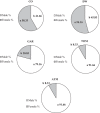Effect of aromatase inhibitors on sex differentiation and embryonic development in chicks
- PMID: 34472216
- PMCID: PMC8604131
- DOI: 10.1002/vms3.623
Effect of aromatase inhibitors on sex differentiation and embryonic development in chicks
Abstract
Background: Sexual differentiation can occur after exposure to aromatase into the left gonad at 6.5 days of incubation. Aromatase inhibitors work by inhibiting the action of the aromatase, which converts androgens into estrogens by a process called aromatization.
Objectives: The aim of this study was to investigate the effect of in ovo exposure to the aromatase inhibitor from tomato and garlic extract on sexual differentiation and embryonic development in chicken embryos.
Methods: Three hundred eggs divided into five groups: Control 1 (CO; no injection); control 2 distilled water, DW; 0.1 ml/egg); garlic extract (GAR; 0.1 mg/egg); tomato extract (TOM; 0.1 mg/egg); and garlic and tomato extract mixed (ATM, 0.1 ml/egg). The solution was prepared and injected into the albumin from the thin end of the eggs on day five by using a 1 ml syringe with a 23-gauge needle. The embryonic test (embryo/egg weight) conducted at 7, 14 and 17 days of incubation. After hatching, feather sexing conducted to determine the initial male. Chicks sex was later confirmed on day 42 by an optical microscope lens.
Results: The results revealed that there was a significant increase (p < 0.01) in embryonic growth traits in all experimental treatments as compared to control treatments. There was a significant increase (p < 0.01) in the percentage of hatchability for all experimental treatments compared to control treatments and a significant increase (p < 0.01) in chick quality including one-day-old chick length and body weight. All experimental treatments showed a significant increase (p < 0.01) in the male-to-female ratio compared to control treatments.
Conclusions: The effect of in ovo exposure to aromatase inhibitors stimulated female-to-male sex reversal and improved embryonic development.
Keywords: aromatase; chicks; embryo; in ovo; sex differentiation.
© 2021 The Authors. Veterinary Medicine and Science published by John Wiley & Sons Ltd.
Figures


References
-
- Abdulateef, S. M. (2017). The effect of maternal care (acoustic stimulus) on embryonic development and hatching muscle of broiler chickens. Iraqi Journal of Agricultural Sciences, 48(5), 1263–1274. https://jcoagri.uobaghdad.edu.iq/index.php/intro/article/view/336
-
- Abushita, A. A. , Hebshi, E. A. , Daood, H. G. , & Biacs, P. A. (1997). Determination of antioxidant vitamins in tomatoes. Food Chemistry, 60(2), 207–212.
-
- Adler, A. J. , & Holub, B. J. (1997). Effect of garlic and fish‐oil supplementation on serum lipid and lipoprotein concentrations in hypercholesterolemic men. The American Journal of Clinical Nutrition, 65(2), 445–450. - PubMed
-
- Ahuja, K. D. , Pittaway, J. K. , & Ball, M. J. (2006). Effects of olive oil and tomato lycopene combination on serum lycopene, lipid profile, and lipid oxidation. Nutrition, 22(3), 259–265. - PubMed
-
- Akazome, Y. , Abe, T. , & Mori, T. (2002). Differentiation of chicken gonad as an endocrine organ: Expression of LH receptor, FSH receptor, cytochrome P450c17 and aromatase genes. Reproduction, 123(5), 721–728. - PubMed
MeSH terms
Substances
LinkOut - more resources
Full Text Sources
Research Materials
Miscellaneous

